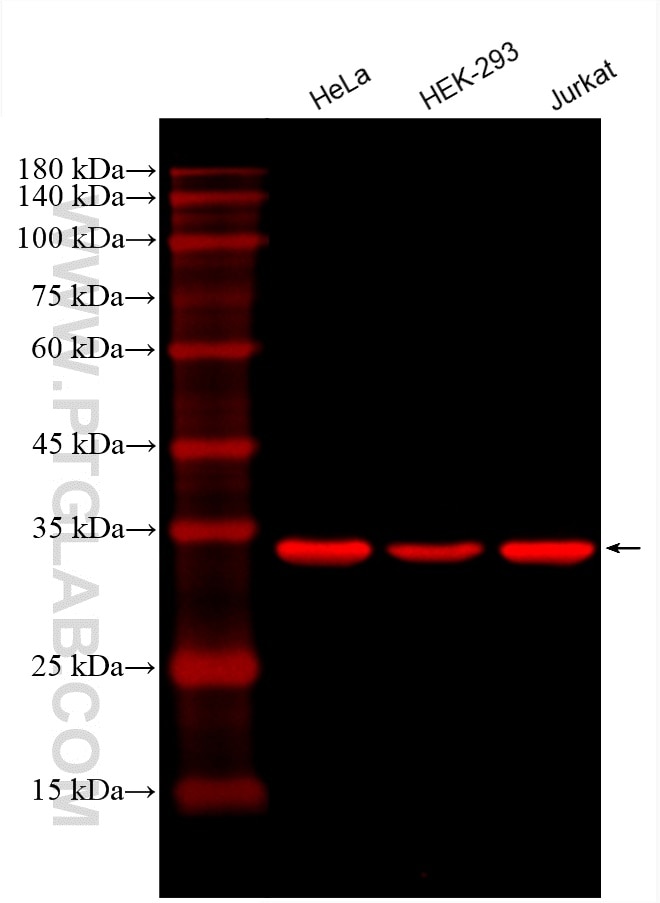- Featured Product
- KD/KO Validated
GAPDH Monoklonaler Antikörper
GAPDH Monoklonal Antikörper für WB, FC (Intra)
Wirt / Isotyp
Maus / IgG2b
Getestete Reaktivität
Hefe, human, Maus, Ratte, Zebrafisch
Anwendung
WB, IF, FC (Intra)
Konjugation
CoraLite®594 Fluorescent Dye
CloneNo.
1E6D9
Kat-Nr. : CL594-60004
Synonyme
Geprüfte Anwendungen
| Erfolgreiche Detektion in WB | HeLa-Zellen, HEK-293-Zellen, Jurkat-Zellen |
| Erfolgreiche Detektion in FC (Intra) | HeLa-Zellen |
Empfohlene Verdünnung
| Anwendung | Verdünnung |
|---|---|
| Western Blot (WB) | WB : 1:5000-1:50000 |
| Durchflusszytometrie (FC) (INTRA) | FC (INTRA) : 0.40 ug per 10^6 cells in a 100 µl suspension |
| It is recommended that this reagent should be titrated in each testing system to obtain optimal results. | |
| Sample-dependent, check data in validation data gallery | |
Veröffentlichte Anwendungen
| WB | See 6 publications below |
| IF | See 1 publications below |
Produktinformation
CL594-60004 bindet in WB, IF, FC (Intra) GAPDH und zeigt Reaktivität mit Hefe, human, Maus, Ratten, Zebrafisch
| Getestete Reaktivität | Hefe, human, Maus, Ratte, Zebrafisch |
| In Publikationen genannte Reaktivität | human, Maus, Ratte |
| Wirt / Isotyp | Maus / IgG2b |
| Klonalität | Monoklonal |
| Typ | Antikörper |
| Immunogen | GAPDH fusion protein Ag0766 |
| Vollständiger Name | glyceraldehyde-3-phosphate dehydrogenase |
| Berechnetes Molekulargewicht | 36 kDa |
| Beobachtetes Molekulargewicht | 36 kDa |
| GenBank-Zugangsnummer | BC004109 |
| Gene symbol | GAPDH |
| Gene ID (NCBI) | 2597 |
| Konjugation | CoraLite®594 Fluorescent Dye |
| Excitation/Emission maxima wavelengths | 588 nm / 604 nm |
| Form | Liquid |
| Reinigungsmethode | Protein-A-Reinigung |
| Lagerungspuffer | PBS with 50% glycerol, 0.05% Proclin300, 0.5% BSA |
| Lagerungsbedingungen | Bei -20°C lagern. Vor Licht schützen. Nach dem Versand ein Jahr stabil. Aliquotieren ist bei -20oC Lagerung nicht notwendig. 20ul Größen enthalten 0,1% BSA. |
Hintergrundinformationen
Glyceraldehyde-3-phosphate dehydrogenase (GAPDH) catalyzes the phosphorylation of glyceraldehyde-3-phosphate during glycolysis. GAPDH participates in nuclear events including transcription, binding RNA, RNA transportation, DNA replication, DNA repair and apoptosis. Being stably and constitutively expressed at high levels in most tissues and cells, GAPDH is considered a housekeeping protein. It is widely used as a control for RT-PCR and also loading control in electrophoresis and Western blotting. GAPDH is normally expressed in cellular cytoplasm or membrane, but can occasionally translocate to the nucleus after the addition of post-translational modifications such as S-nitrosylation. This antibody is raised against full length GAPDH of human origin. It can recognize the 36 kDa GAPDH protein in most cells/tissues. In addition, a band below 36 kDa can always be detected as the isoform or spliced product of GAPDH (PMID: 23885286, 23877755, 19368702). Please note that some physiological factors, such as hypoxia and diabetes, increase GAPDH expression in certain cell types.
Protokolle
| PRODUKTSPEZIFISCHE PROTOKOLLE | |
|---|---|
| WB protocol for CL594 GAPDH antibody CL594-60004 | Protokoll herunterladen |
| FC protocol for CL594 GAPDH antibody CL594-60004 | Download protocol |
| STANDARD-PROTOKOLLE | |
|---|---|
| Klicken Sie hier, um unsere Standardprotokolle anzuzeigen |
Publikationen
| Species | Application | Title |
|---|---|---|
Cell Signal A novel role of ADAMTS16 in renal fibrosis through activating TGF-β/Smad signaling | ||
BMC Cancer Oridonin-induced ferroptosis and apoptosis: a dual approach to suppress the growth of osteosarcoma cells | ||
Brain Sci Itaconate Attenuates Neuroinflammation and Exerts Dopamine Neuroprotection in Parkinson's Disease through Inhibiting NLRP3 Inflammasome | ||
Cell Chem Biol Identification of KLHDC2 as an efficient proximity-induced degrader of K-RAS, STK33, β-catenin, and FoxP3 | ||
Int J Mol Med Flavin containing monooxygenase 2 regulates renal tubular cell fibrosis and paracrine secretion via SMURF2 in AKI‑CKD transformation | ||
Front Immunol Increased neutrophil extracellular trap formation in oligoarticular, polyarticular juvenile idiopathic arthritis and enthesitis-related arthritis: biomarkers for diagnosis and disease activity |



